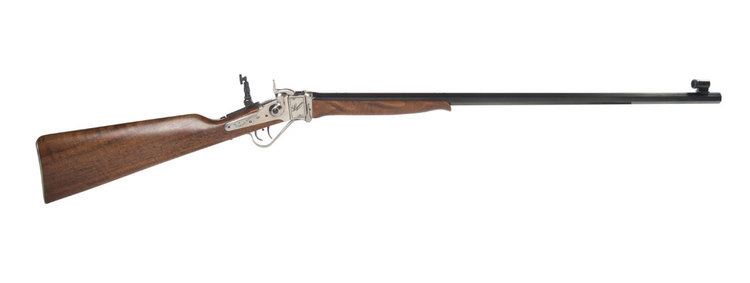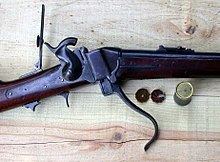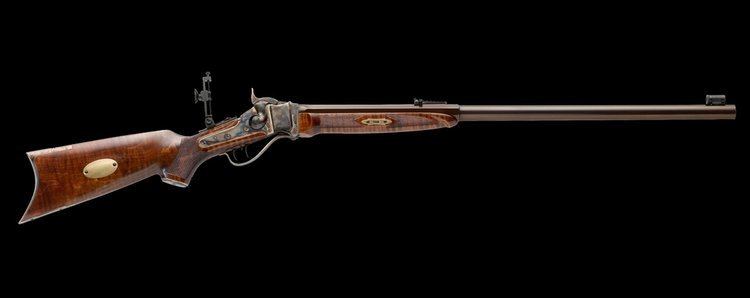Type Rifle, Carbine In service 1850–1881 Designed 1848 | No. built 120,000+ | |
Sharps rifles are a series of large-bore single-shot rifles, beginning with a design by Christian Sharps in 1848, and ceasing production in 1881. They are renowned for long-range accuracy. By 1874 the rifle was available in a variety of calibers and had been adopted by the armies of a number of nations and was one of the few successful designs to transition to metallic cartridge use.
Contents
- Lyman model of 1878 the 1877 creedmoor sharps rifle
- History
- Sharps military rifles and carbines
- Sharps military carbine
- Sharps sporting rifles
- Cultural significance
- References
Reproductions of the Sharps rifle are currently made by different rifle companies and the rifle has become an icon of the Old West due to its use in a number of movies and books in the Western genre.

Lyman model of 1878 the 1877 creedmoor sharps rifle
History

Sharps' initial rifle was patented September 12, 1848 and manufactured by A. S. Nippes at Mill Creek, (Philadelphia) Pennsylvania, in 1850.

The second model used the Maynard tape primer, and surviving examples are marked Edward Maynard - Patentee 1845. In 1851 the second model was brought to the Robbins & Lawrence Company of Windsor, Vermont where the Model 1851 was developed for mass production. Rollin White of the R&L Co. invented the knife-edge breech block and self-cocking device for the "box-lock" Model 1851. This is referred to as the "First Contract", which was for 10,000 Model 1851 carbines - of which approximately 1,650 were produced by R&L in Windsor.

In 1851 the "Second Contract" was made for 15,000 rifles and the Sharps Rifle Manufacturing Company was organized as a holding company with $1,000 in capital and with John C. Palmer as president, Christian Sharps as engineer, and Richard S. Lawrence as master armorer and superintendent of manufacturing. Sharps was to be paid a royalty of $1 per firearm and the factory was built on R&L's property in Hartford, Connecticut.

The Model 1851 was replaced in production by the Model 1853. Christian Sharps left the company in 1855 to form his own manufacturing company called "C. Sharps & Company" in Philadelphia; Richard S. Lawrence continued as the chief armorer until 1872 and developed the various Sharp models and their improvements that made the rifle famous. In 1874, the company was reorganized and renamed "The Sharps Rifle Company" and it remained in Hartford until 1876, whereupon it relocated to Bridgeport, Connecticut.
The 1874-pattern Sharps was a particularly popular rifle that led to the introduction of several derivatives in quick succession. It handled a large number of .40- to .50-caliber cartridges in a variety of loadings and barrel lengths.
Hugo Borchardt designed the Sharps-Borchardt Model 1878, the last rifle made by the Sharps Rifle Co. before its closing in 1881.
Reproductions of the paper cartridge Sharps M1859 and M1863 Rifle and Carbine, the metallic cartridge 1874 Sharps Rifle, and Sharps-Borchardt Model 1878 are being manufactured today. They are used in Civil War re-enacting, hunting and target shooting.
Sharps military rifles and carbines
The military Sharps rifle was a falling block rifle used during and after the American Civil War in multiple variations. Along with being able to use a standard percussion cap, the Sharps had a fairly unusual pellet primer feed. This was a device which held a stack of pelleted primers and flipped one over the nipple each time the trigger was pulled and the hammer fell - making it much easier to fire a Sharps from horseback than a gun employing individually loaded percussion caps.
The Sharps Rifle was produced by the Sharps Rifle Manufacturing Company in Hartford, Connecticut. It was used in the Civil War by multiple Union units, most famously by the U.S. Army Marksman, known popularly as "Berdan's Sharpshooters" in honor of their leader Hiram Berdan. The Sharps made a superior sniper weapon of greater accuracy than the more commonly issued muzzle-loading rifled muskets. This was due mainly to the higher rate of fire of the breech loading mechanism and superior quality of manufacture, as well as the ease of which it could be reloaded from a kneeling or prone position.
At this time however, many officers were distrustful of breech-loading weapons on the grounds that they would encourage men to waste ammunition. In addition, the Sharps Rifle was expensive to manufacture (three times the cost of a muzzle-loading Springfield rifle) and so only 11,000 of the Model 1859s were produced. Most were unissued or given to sharpshooters, but the 13th Pennsylvania Reserves (which still carried the old-fashioned designation of a "rifle regiment") carried them until being mustered out in 1864.
Sharps military carbine
The carbine version was very popular with the cavalry of both the Union and Confederate armies and was issued in much larger numbers than other carbines of the war and was top in production in front of the Spencer or Burnside carbine. The falling block action lent itself to conversion to the new metallic cartridges developed in the late 1860s, and many of these converted carbines in .50-70 Government were used during the Indian Wars in the decades immediately following the Civil War.
Some Civil War-issue carbines had an unusual feature: a hand-cranked grinder in the stock. Although long thought to be a coffee mill, experimentation with some of the few survivors suggests the grinder is ill-suited for coffee. The modern consensus is that its true purpose was for grinding corn or wheat.
Unlike the Sharps rifle, the carbine was very popular and almost 90,000 were produced. By 1863, it was the most common weapon carried by Union cavalry regiments, although in 1864 many were replaced by 7-shot Spencer carbines. Some Sharps clones were produced by the Confederates in Richmond. Quality was generally poorer and they normally used brass fittings instead of iron.
Sharps sporting rifles
Sharps made sporting versions from the late 1840s until the late 1880s. After the American Civil War, converted Army surplus rifles were made into custom firearms, and the Sharps factory produced Models 1869 and 1874 in large numbers for commercial buffalo hunters and frontiersmen. These large-bore rifles were manufactured with some of the most powerful black powder cartridges ever made. Sharps also fabricated special long-range target versions for the then-popular Creedmore style of 1,000-yard (910 m) target shooting. Many modern black powder cartridge silhouette shooters use original and replica Sharps rifles to target metallic silhouettes cut in the shapes of animals at ranges up to 500 meters. Shiloh Rifle Manufacturing Company, and C Sharps Arms of Big Timber, Montana, have been manufacturing reproductions of the Sharps Rifle since 1983 and 1979, respectively.
Cultural significance
In the 1990 western Quigley Down Under, Tom Selleck's title character uses a Sharps rifle. Theater Crafts Industry went so far as to say, "In Quigley Down Under, which we did in 1990, the Sharps rifle practically co-stars with Tom Selleck." This statement was echoed by gunwriters including John Taffin in Guns and Lionel Atwill in Field & Stream, crediting the film with an impact to rival that of Dirty Harry on the Smith & Wesson .44 Magnum. The rifle in Quigley has a 34" barrel length, as opposed to the standard 30" length. Firearms manufacturers such as Davide Pedersoli and Shiloh Rifle Manufacturing Company have credited these movies with an increase in demand for those rifles. As a result of the popularity of the film, a Sharps match is held annually in Forsyth, Montana known as the "Matthew Quigley Buffalo Rifle Match". Originally a 44-inch target was placed at 1,000 yards for each shooter, remniscent of a scene from the movie. The match is billed as the "biggest rifle event shooting in Eastern Montana since the Custer Massacre" and has since developed into a two-day competition with eight shots for score on six steel silhouette targets at ranges from 350 to 805 yards.
On television, the Sharps rifle plays a central role in the murder investigation in the pilot episode of the Longmire series (2012). A Sharps is the weapon used in the murder, and its firing action is central to the climactic action sequence (it takes five seconds to reload after firing). In the Longmire novel The Cold Dish the author is incorrect in ascribing the name Sharpshooter to the Sharps. The term sharpshooter, referring to marksman had its origin in English from at least 1801 from the German term Scharfschütze.
